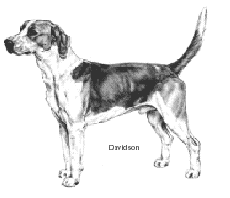Harrier
General Information - Harrier

Group:
Hound
Size:
large
Lifespan:
10-12 years
Exercise:
high
Grooming:
very low
Trainability:
low
Watchdog ability:
very high
Protection ability:
very low
Area of Origin:
England
Date of Origin:
Middle ages
Other Names:
none
Original Function:
Trailing hares
History
The Harrier is a very old hound, originating in Great Britain in the 1200's. It is descended from the larger Foxhound, the Greyhound, and the Fox Terrier. It was used to hunt hares as its name implies, and worked best in packs, while the hunter followed on foot. This tireless hunter has an acute sense of smell, and once on the scent of its prey, can generally outlast the prey.
Temperament
The Harrier is somewhat more playful and outgoing than the Foxhound, but not as much as the Beagle. Cheerful, sweet-tempered, and tolerant, it is excellent with children. This pack dog is good with other dogs, but should be supervised with non-canine pets – unless it is raised with them from puppyhood. It prefers life in a pack with people, dogs, or both. This active dog likes to go exploring, sniffing and trailing, so be sure to keep it on a leash or in a safe enclosed area. Some Harriers like to bay.
Upkeep
The Harrier needs daily exercise, but its needs can be met with a long walk or jog and a vigorous game in the yard. It can live outdoors in temperate climates as long as it is given warm shelter and bedding. The coat is easily cared for, needing only occasional brushing to remove dead hair.
Harrier
A breed standard is the guideline which describes the ideal characteristics, temperament, and appearance of a breed and ensures that the breed is fit for function with soundness essential. Breeders and judges should at all times be careful to avoid obvious conditions and exaggerations, as well as being mindful of features which could be detrimental in any way to the health, welfare or soundness of this breed.
Breed Standard - Harrier
 Characteristics
Characteristics: An active, well balanced, well muscled and well boned hound, full of strength and quality. Fearless, though of a kindly nature in or out of the pack.
Head: Broad skull with plenty of brain room. Stop slightly pronounced with a straight and powerful muzzle. Nose wide with open nostrils. An expression of great alertness, a little wicked at times. Head must be well set up on a neck of ample length, clean cut and strong.
Ears: Set high, lying close to the cheek and broad.
Legs: Forelegs straight with plenty of bone running right down to the toes but not overburdened but inclined to knuckle over slightly without exaggeration. Toes turned slightly inwards.
Feet: Cat:like with close:knit toes and strong pads. A hound must stand right up on his toes.
Hindlegs: Legs and hocks stand square with a good bend of stifle and muscular thigh to take the weight off his body. Hocks well let down.
Elbows: Points set well away from the ribs, running parallel to the body and turning neither in nor out.
Body: The back should be level and muscular, slightly dipping behind the withers and not arching over the loins. Deep, well-sprung ribs, running well back with plenty of heart room and a deep chest.
Stern: Well set up, long and well controlled and rising higher than the back.
Coat: Short, dense, hard and glossy. Hair on the chest and under:side of the flag longer than body length.
Colour: Any hound colour.
Height: 45.7 - 53.3 cm (18 - 21 in), 48.2 cm (19 in) being the ideal.
Notes: The true modern Harrier is now divorced from inter-breeding of the Fox Hound and Beagle and is bred in its own right. Though the Standard has not been acknowledged by the Kennel Club (England) it has been in other countries. Also the Harrier is exhibited each year at the great Peterborough Hound Show in its own group.
The old idea of points making the Harrier a similar but smaller Fox Hound is not now recognised to the full extent by Harrier packs; he is now an individual and has developed a type of his own.
Note: Male animals should have two apparently normal testicles fully descended into the scrotum.
DNZ No 472
Copyright Dogs New Zealand
01 Jan 2002
Any departure from the foregoing points should be considered a fault and the seriousness with which the fault should be regarded should be in exact proportion to its degree and its effect upon the health and welfare of the dog and on the dog’s ability to perform its traditional work.




